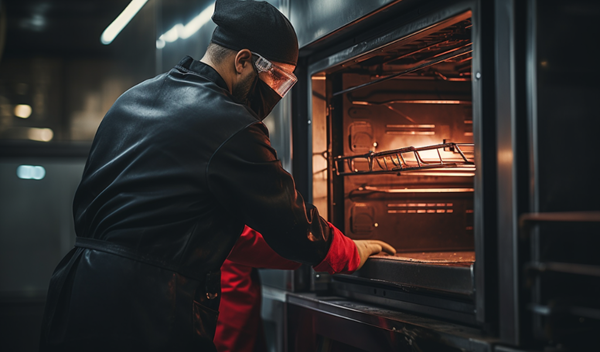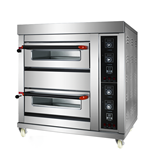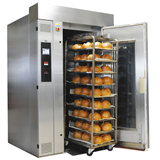Commercial kitchens are bustling hubs of culinary creativity, where delicious dishes are crafted to tantalize taste buds. However, amid the flurry of activity, safety and compliance must remain at the forefront to ensure the well-being of kitchen staff and patrons. Convection ovens, an integral part of these kitchens, demand particular attention when it comes to safety and compliance.
In this comprehensive guide, we explore essential safety measures for operating convection ovens, considerations for proper ventilation and airflow, compliance with industry standards and regulations, staff training protocols, accident and fire hazard prevention strategies, and emergency procedures and equipment.
By prioritizing safety and compliance in commercial kitchens, we create a secure and productive environment that celebrates culinary excellence.
- Safety Measures for Operating Convection Ovens
Convection ovens are powerful appliances that require careful operation to prevent accidents and injuries. Implementing comprehensive safety measures ensures the well-being of kitchen staff and the efficient functioning of the ovens.
Here are some essential safety measures for operating convection ovens:
- Proper Installation: Ensure that convection ovens are installed correctly by following the manufacturer's guidelines and using approved installation methods. Improper installation can lead to hazards, such as electrical issues or uneven heating.
- Regular Inspections: Schedule regular inspections of the ovens to identify any signs of wear, damage, or malfunction. Address issues promptly to prevent further complications and ensure optimal performance.
- Safe Distance from Combustibles: Maintain a safe distance between the oven and combustible materials, such as wooden cabinets or flammable cleaning agents. Adequate clearance prevents the risk of fire hazards.
- Operating Temperature Awareness: Train staff to be aware of the oven's operating temperature. Avoid touching hot surfaces and use appropriate protective gear, such as oven mitts, to prevent burns.
- Avoid Overloading: Adhere to the oven's capacity limits and avoid overcrowding trays or racks. Overloading can disrupt proper airflow, leading to uneven cooking and potential accidents.
- Caution with Steam Release: Exercise caution when opening the oven door, especially during steam release. Steam burns can be severe, so open the door away from your body and use a dry cloth to protect your hands.
- Cleaning and Maintenance: Regularly clean and maintain the oven to prevent the buildup of grease, which can be a fire hazard. Follow the manufacturer's cleaning guidelines and use approved cleaning agents.
By implementing these safety measures, commercial kitchens can create a secure environment for operating convection ovens, safeguarding both the staff and the kitchen's overall functionality.
-
Ventilation and Airflow Considerations
Proper ventilation and airflow management are crucial in commercial kitchens, especially when operating convection ovens. These appliances produce heat, steam, and cooking fumes, which must be effectively managed to maintain a comfortable and safe working environment. Consider the following ventilation and airflow considerations:
- Exhaust Hood Systems: Install exhaust hood systems above convection ovens to capture and remove cooking fumes and heat. Properly designed hood systems ensure efficient ventilation and prevent the accumulation of grease and odors in the kitchen.
- Ductwork and Airflow Direction: Ensure that ductwork is adequately sized and directed to expel cooking emissions outside the building. Proper airflow direction prevents the recirculation of polluted air, maintaining air quality in the kitchen.
- Makeup Air Systems: In conjunction with exhaust hoods, consider installing makeup air systems to balance air pressure and ensure a steady supply of fresh air. This prevents negative pressure, which can impede proper exhaust operation.
- Filters and Grease Management: Regularly clean and replace exhaust hood filters to prevent grease buildup. Grease accumulation poses a fire hazard and can reduce the efficiency of ventilation systems.
- Consideration of Kitchen Layout: When designing the kitchen layout, strategically position convection ovens and exhaust hoods to optimize airflow and ventilation efficiency.
- Balancing Temperature and Comfort: Proper ventilation not only removes cooking emissions but also helps regulate kitchen temperatures, ensuring a comfortable working environment for staff.
Effective ventilation and airflow management not only enhance safety but also contribute to the overall well-being of kitchen staff and the preservation of a clean and pleasant kitchen environment.
-
Compliance with Industry Standards and Regulations
Adherence to industry standards and regulations is a non-negotiable aspect of safety and compliance in commercial kitchens. These standards are established to protect the well-being of workers and patrons while maintaining the integrity of the culinary industry. Here are some key considerations for compliance:
- National Fire Protection Association (NFPA) Codes: Comply with NFPA codes and standards related to commercial kitchen safety, including NFPA 96 for ventilation control and NFPA 54 for gas-fired equipment.
- Occupational Safety and Health Administration (OSHA) Guidelines: Adhere to OSHA guidelines concerning the safe operation of kitchen equipment, safe handling of chemicals, and personal protective equipment (PPE) usage.
- Local Health Department Regulations: Familiarize yourself with local health department regulations governing foodservice establishments, ensuring that your kitchen meets all requirements.
- Gas and Electrical Safety: Regularly inspect gas and electrical connections to ensure compliance with safety regulations. Faulty connections can lead to gas leaks or electrical hazards.
- Employee Training Records: Maintain comprehensive records of employee training sessions related to safety protocols and equipment usage. Training records demonstrate a commitment to safety and compliance.
- Emergency Exits and Signage: Ensure that the kitchen has clearly marked emergency exits and evacuation routes, as well as visible safety signage throughout the space.
- Material Safety Data Sheets (MSDS): Keep up-to-date MSDS for all chemicals used in the kitchen. MSDS provides vital information about the safe handling and storage of hazardous substances.
Compliance with industry standards and regulations not only fosters a safe environment but also protects businesses from potential legal liabilities and fines.
It is imperative for commercial kitchens to stay informed and updated on relevant guidelines to ensure a safe and compliant working environment.
Training Staff for Proper Oven Usage
A well-trained and knowledgeable staff is a critical component of a safe and efficient commercial kitchen. Proper training for convection oven usage ensures that staff members can confidently operate the equipment while minimizing the risk of accidents. Consider the following training protocols:
- Manufacturer's Guidelines: Begin by thoroughly familiarizing staff with the manufacturer's guidelines and instructions for the specific convection ovens used in the kitchen.
- Operating Procedures: Train staff on the proper procedures for preheating the oven, setting cooking temperatures and times, and loading and unloading trays or racks.
- Safety Protocols: Emphasize safety protocols, such as using oven mitts, avoiding overcrowding, and being cautious when opening the oven door during steam release.
- Emergency Procedures: Educate staff on emergency procedures, including how to operate fire suppression systems and evacuate the kitchen in case of a fire or other emergencies.
- Maintenance and Cleaning: Instruct staff on proper oven cleaning and maintenance procedures, including how to safely use cleaning agents and schedule regular maintenance checks.
- Hands-On Training: Provide hands-on training sessions where staff can practice operating the convection ovens under supervision.
- Periodic Refresher Courses: Conduct periodic refresher courses to reinforce proper oven usage and safety measures.
By investing in comprehensive staff training, commercial kitchens can create a team of competent professionals who prioritize safety and possess the skills necessary to operate convection ovens efficiently.
-
Preventing Accidents and Fire Hazards
Preventing accidents and fire hazards is of paramount importance in a high-temperature environment like a commercial kitchen. The following strategies can significantly reduce the risk of accidents and fires:
- Regular Equipment Inspections: Schedule regular inspections of convection ovens and other kitchen equipment to identify potential hazards or signs of wear.
- Grease Trap Maintenance: Keep grease traps and exhaust hoods clean to prevent grease buildup, which can lead to fire hazards.
- Fire Suppression Systems: Install automatic fire suppression systems in the kitchen, especially near cooking equipment, to quickly extinguish fires and prevent their spread.
- Fire Extinguishers: Have accessible fire extinguishers in the kitchen and ensure that staff knows how to operate them effectively.
- Flammable Storage: Store flammable substances, such as cleaning agents, away from heat sources and cooking areas.
- Electrical Safety: Regularly inspect electrical connections and avoid overloading circuits to prevent electrical hazards.
- Fire Drills and Emergency Plans: Conduct fire drills regularly and have well-defined emergency plans to ensure that staff knows how to respond in case of a fire.
Preventing accidents and fire hazards requires a proactive approach and a vigilant staff. By implementing these strategies and fostering a safety-conscious culture, commercial kitchens can significantly reduce the risk of accidents and promote a secure working environment.
-
Emergency Procedures and Equipment
Even with meticulous safety measures in place, emergencies can still occur in commercial kitchens. Being prepared for emergencies and having the appropriate equipment at hand can make all the difference in mitigating potential risks. Consider the following emergency procedures and equipment:
- First Aid Kits: Have fully stocked first aid kits readily available in the kitchen to provide immediate care for minor injuries.
- Emergency Contacts: Display a list of emergency contacts, including local fire departments, medical facilities, and poison control, in a visible location.
- Fire Alarm Systems: Install fire alarm systems throughout the kitchen to quickly alert staff in case of a fire.
- Fire Blankets: Keep fire blankets in the kitchen to smother small fires or to use as protective wraps in case of burns.
- Emergency Exits: Ensure that emergency exits are clearly marked and free of obstructions for quick evacuation.
- Fire Drill Practice: Regularly conduct fire drills to ensure that staff is familiar with evacuation routes and procedures.
- Fire Suppression Training: Train staff in the proper use of fire suppression systems to effectively control and extinguish fires.
- Emergency Lighting: Install emergency lighting to maintain visibility during power outages or evacuation.
Having well-defined emergency procedures and readily available equipment can significantly reduce the impact of emergencies, ensuring the safety of kitchen staff and patrons.
Safety and compliance are essential pillars in the realm of commercial kitchens, and convection ovens require particular attention to prevent accidents and ensure smooth operations. By adhering to safety measures for operating convection ovens, considering ventilation and airflow, complying with industry standards, and investing in staff training, commercial kitchens create a secure and productive environment.
Preventing accidents and fire hazards through regular inspections, proper equipment maintenance, and proactive safety measures further enhances the safety quotient. Lastly, being prepared for emergencies with well-defined procedures and accessible emergency equipment ensures swift and effective responses in times of crisis.
By embracing safety and compliance as core values, commercial kitchens foster a culture of well-being and excellence that delights both kitchen staff and patrons alike.



-160x160-state_article-rel-cat.png)



-160x160-state_article-rel-cat.png)


















